

Unspeakableness. Investigation in Emotion Classification This is the early stage research of the project.

In late January, 2012, I emailed around Royal College of Art asking for words describing emotions in languages other than English that are untranslatable into English. Interesting enough, in order to understand the untranslatable words I had to have several correspondence with the person who contributed the word, and through this back-and-forth discussion can I actually get the glimpse of the emotion itself. The Ekmans' Atlas of Emotions. Welcome to the Atlas of Emotions This atlas was inspired by a series of conversations between the Dalai Lama and Paul Ekman about the science of emotions.

With the help of Stamen Design and Paul’s daughter, Dr. Eve Ekman, this tool was created to be a visual journey through the world of emotions. Learn more about the work of Paul Ekman at www.paulekman.com. What it’s based on. To Help Students Learn, Engage the Emotions. Photo Before she became a neuroscientist, Mary Helen Immordino-Yang was a seventh-grade science teacher at a school outside Boston.
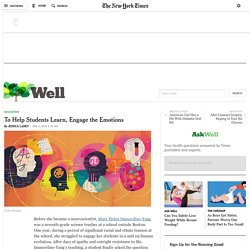
One year, during a period of significant racial and ethnic tension at the school, she struggled to engage her students in a unit on human evolution. After days of apathy and outright resistance to Ms. Immordino-Yang’s teaching, a student finally asked the question that altered her teaching — and her career path — forever: “Why are early hominids always shown with dark skin?” With that question, one that connected the abstract concepts of human evolution and the very concrete, personal experiences of racial tension in the school, her students’ resistance gave way to interest.
Dr. Her students learned because they became emotionally engaged in material that had personal relevance to them. Emotion is essential to learning, Dr. Women Are Better At Expressing Emotions, Right? Why It's Not That Simple by Mark Greene. This article originally appeared in The Good Men Project.

Parents coach their sons to present a facade of emotional toughness and their daughters to admire that facade in men. There is a commonly held cultural narrative which goes something like this: Men who share their emotions make better husbands and fathers. Women value this in a prospective partner because women are already naturally able to share their emotions. In a nutshell, women are the emotionally able ones; men can learn to be.
Negative Emotions Are Key to Well-Being. A client sits before me, seeking help untangling his relationship problems.
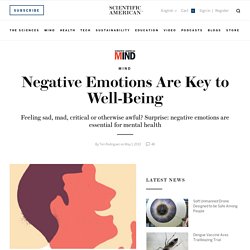
As a psychotherapist, I strive to be warm, nonjudgmental and encouraging. I am a bit unsettled, then, when in the midst of describing his painful experiences, he says, “I'm sorry for being so negative.” Should Researchers Get Emotional? Professor Mark Reed of Birmingham City University explores whether researchers should use emotion to communicate their work to decision-makers.
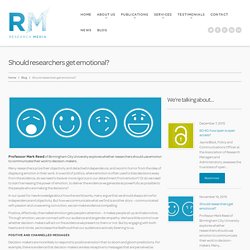
Many researchers prize their objectivity and detached independence, and recoil in horror from the idea of displaying emotion in their work. In a world of politics, where emotion is often used to bias decisions away from the evidence, do we need to be ever more rigorous in our detachment from emotion? Or do we need to start harnessing the power of emotion, to deliver the evidence we generate as powerfully as possible to the people who are making the decisions? In our quest for new knowledge about how the world works, many argue that we should always strive for independence and objectivity.
On Being Too Much for Ourselves: Psychoanalyst Adam Phillips on Balance and the Necessary Excesses of Life. By Maria Popova “There are situations in which it is more dangerous to keep your balance than to lose it.”
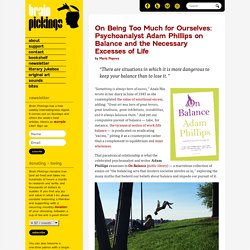
“Something is always born of excess,” Anaïs Nin wrote in her diary in June of 1945 as she contemplated the value of emotional excess, adding: “Great art was born of great terrors, great loneliness, great inhibitions, instabilities, and it always balances them.” And yet our compulsive pursuit of balance — take, for instance, the tyrannical notion of work/life balance — is predicated on eradicating “excess,” pitting it as a counterpoint rather than a complement to equilibrium and inner wholeness. That paradoxical relationship is what the celebrated psychoanalyst and writer Adam Phillips examines in On Balance (public library) — a marvelous collection of essays on “the balancing acts that modern societies involve us in,” exploring the many myths that bedevil our beliefs about balance and impede our pursuit of it.
Emotional Intelligence: The Social Skills You Weren't Taught in School. Women: Please Don't Hold Back. ~ Ben Wills. *Update via The New York Times: “Women are moody.

Leo Tolstoy on Emotional Infectiousness and What Separates Good Art from Bad. By Maria Popova “A real work of art destroys, in the consciousness of the receiver, the separation between himself and the artist.”
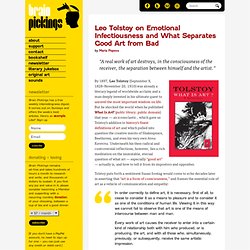
By 1897, Leo Tolstoy (September 9, 1828–November 20, 1910) was already a literary legend of worldwide acclaim and a man deeply invested in his ultimate quest to unravel the most important wisdom on life. But he shocked the world when he published What Is Art? (public library; public domain) that year — an iconoclastic , which gave us Tolstoy’s addition to history’s finest definitions of art and which pulled into question the creative merits of Shakespeare, Beethoven, and even his very own Anna Karenina. Underneath his then-radical and controversial reflections, however, lies a rich meditation on the immutable, eternal question of what art — especially “good art” — actually is, and how to tell it from its impostors and opposites.
Tolstoy defies the academy’s intellectualizations of art: How Highly Sensitive People Can Learn To Be Vulnerable. 5 Decisions To Avoid For A Regret-Free Life Life is short, and time is the one thing we'll never get back.

In our minds we understand this, but far too many of us don't live our life this way. We have hopes, dreams, and things we've always Read. Why We Cry: The Science of Sobbing and Emotional Tearing. By Maria Popova Why it’s easier to prevent a crying spell than to stop one already underway. The human body is an extraordinary machine, and our behavior an incessant source of fascination. In Curious Behavior: Yawning, Laughing, Hiccupping, and Beyond (public library), psychology and neuroscience professor Robert R. Do Not Despise Your Inner World: Advice on a Full Life from Philosopher Martha Nussbaum. Why We Cry: The Science of Sobbing and Emotional Tearing. Your Mind & Body Are Not Separate. For more: This isn’t news to anyone, right? Ron Gutman: The hidden power of smiling. How to Optimize Your Brain: Why Refining Emotional Recall is the Secret to Better Memory.
By Maria Popova “You are what you remember — your very identity depends on all of the events, people and places you can recall.” We’ve seen the many ways in which our memory can be our merciless traitor: it is not a recording device but a practitioner of creative plagiarism, a terrible timekeeper, and the bent backbone in the anatomy of lying. How, then, can this essential human faculty become our ally? Paul Bloom: The origins of pleasure. 5 Things Every Presenter Should Know About People, Animated. The Science of Dreams and Why We Have Nightmares. By Maria Popova The psychology of our built-in nocturnal therapy. “The interpretation of dreams is the royal road to a knowledge of the unconscious activities of the mind,” Freud argued in his influential treatise The Interpretation of Dreams in 1900.
“The earth is heavy and opaque without dreams,” Anaïs Nin wrote in her diary in 1940. “In the olden days, people believed that our dreams were full of clues about the future,” Alain de Botton told a little kid who wanted to know about dreaming. What Is Character? Debunking the Myth of Fixed Personality. Why We Cry: The Science of Sobbing and Emotional Tearing. Leo Tolstoy on Emotional Infectiousness and What Separates Good Art from Bad. Why Time Slows Down When We’re Afraid, Speeds Up as We Age, and Gets Warped on Vacation. By Maria Popova “Time perception matters because it is the experience of time that roots us in our mental reality.” Given my soft spot for famous diaries, it should come as no surprise that I keep one myself. Facing Ourselves: The Climate Challenge Needs a New Kind of Bravery by YES! online staff. Goethe on the Psychology of Color and Emotion.
Color is an essential part of how we experience the world, both biologically and culturally. Blind athletes provide clues about the nature of our emotions. One of the most important ways that we learn how to interact with the world around us is through observational learning. By watching how our friends and family members behave, we learn at a very young age how to do things like turn on a lightbulb, open a door, or play with a doll, without having to suffer through a tedious trial-by-error reinforcement process every single time we need to learn how to do something new. Hidden Metaphors Get under Our Skin. Look around. Do you see four walls or an expansive vista? The answer could influence your ability to think creatively.